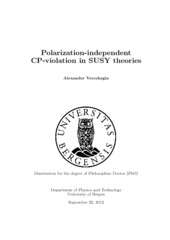| dc.contributor.author | Vereshagin, Alexander | eng |
| dc.date.accessioned | 2013-05-10T08:27:15Z | |
| dc.date.available | 2013-05-10T08:27:15Z | |
| dc.date.issued | 2013-02-01 | eng |
| dc.identifier.isbn | 978-82-308-2219-7 | en_US |
| dc.identifier.uri | https://hdl.handle.net/1956/6595 | |
| dc.description.abstract | Supersymmetry (SUSY) is a beautiful mathematical concept which binds internal symmetries of a quantum field theory with global symmetries of the space-time. Applications of this approach may stretch from unsolved puzzles in particle physics to global problems in cosmology. The elimination of the hierarchy problem in Supersymmetric versions of the Standard Model was the initial strongest motivation to explore SUSY. However, there are other philosophical and technical problems that may found a solution if SUSY is proven to be the part of physical reality. This includes improved ultraviolet convergence of the theory, a way out of the strong restrictions imposed for field-theoretical models by general Coleman-Mandula theorem, potential solution of the so-called “cold dark matter problem” in cosmology, and many others. Building a (realistic) supersymmetric quantum field theory model normally requires introduction of new particles (“superparticles”), and it is not yet clear how one can confirm supersymmetry without detecting some of them. The regular search for supersymmetric events started back in 1980th, but, unfortunately, no direct evidence is still found. Yet, the SUSY studies contribute a big part of particle physics activities; the search for Supersymmetry is one of the main focuses of the on-going experimental program at CERN and at proposed electron–positron linear collider. In particular, it is currently believed that the known sources of CP-violation inside the Standard Model are not sufficient to explain the observed dominance of matter over anti-matter, while SUSY extensions of the Standard Model provide additional sources of CP-violation. It is known that the complex phases of the higgsino and gaugino mass parameters in the Minimal Supersymmetric Standard Model (MSSM) allow for CP violation at low orders of perturbation theory, without invoking the Cabibbo–Kobayashi–Maskawa matrix or the Higgs sector. If the phases are significant, one may expect experimental evidence of CP violation that does not fit the explanation within the (non-supersymmetric) Standard Model. In the light of the International Linear Collider project, it is natural to consider the products of electron–positron annihilation. Typically, to detect a CP-odd observable in a two particle creation process one has to detect spin component (polarization) of some of the particles in addition to the particle momenta, since any scalar product of momenta is even under C and P. It is shown, however, that for chargino pair creation in electron-positron annihilation it is in principle possible to detect CP-violation without measuring polarizations, provided the two final charginos have different masses. It is shown that one can construct a CP-odd observable out of unpolarized cross-sections. This observable, although vanishes at the tree level, acquires non-vanishing contributions starting from 1-loop order. Most of the results are obtained in the simplest version of unconstrained MSSM, however one can easily see that the results hold in a much larger class of less restricted Supersymmetric models. | en_US |
| dc.language.iso | eng | eng |
| dc.publisher | The University of Bergen | en_US |
| dc.relation.haspart | Paper I: Osland, P. & Vereshagin, A. (2007) CP violation in unpolarized e+ e- charginos at one loop level. Physical Review D 76(3): 036001, August 2007. Full text not available in BORA due to publisher restrictions. The article is available at: <a href="http://dx.doi.org/10.1103/PhysRevD.76.036001" target="blank"> http://dx.doi.org/10.1103/PhysRevD.76.036001</a> | en_US |
| dc.relation.haspart | Paper II: Osland, P., Kalinowski, J., Rolbiecki, K. & Vereshagin, A. (2007) Polarization-independent CP-odd Observable in e+e- Chargino Production at One Loop. Proceedings LCWS07, eConf C 0705302. Full text not available in BORA due to publisher restrictions. The article is available at: <a href="http://arxiv.org/abs/0709.3358" target="blank"> http://arxiv.org/abs/0709.3358</a> | en_US |
| dc.title | Polarization-independent CP-violation in SUSY theories | en_US |
| dc.type | Doctoral thesis | |
| dc.rights.holder | Copyright the author. All rights reserved | en_US |
